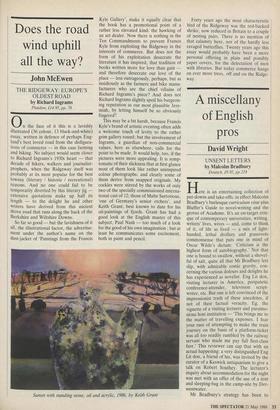Does the road wind uphill all the way?
John McEwen
THE RIDGEWAY: EUROPE'S OLDEST ROAD by Richard Ingrams
Phaidon, £14.95, pp. 78
0 n the face of it this is a lavishly illustrated (36 colour, 13 black-and-white) essay, written in defence of perhaps Eng- land's best loved road from the disfigura- tions of commerce — in this case farming and biking. No subject would seem closer to Richard Ingrams's 1930s heart — that decade of hikers, walkers and journalist- prophets, when the Ridgeway itself was probably at its most popular for the best townee (literary / historic / recreational) reasons. And no one could fail to be temporarily diverted by this literary jig extensive quotations make up half its length — to the delight he and other writers have derived from this ancient drove road that runs along the back of the Berkshire and Wiltshire Downs.
So far so good — but the lavishness of it all, the illustrational factor, the advertise- ment under the author's name on the dust-jacket of 'Paintings from the Francis Kyle Gallery', make it equally clear that the book has a promotional point of a rather less elevated kind: the hawking of an art dealer. Now there is nothing in the Ten Commandments to prevent Francis Kyle from exploiting the Ridgeway in the interests of commerce. But does not the form of his exploitation desecrate the literature it has inspired, that tradition of books written more for love than gain and therefore desecrate our love of the place — less outrageously, perhaps, but as insidiously as the farmers and bike manu- facturers who are the chief villains of Richard Ingrams's piece? And does not Richard Ingrams slightly spoil his burgeon- ing reputation as our most plausible Jere- miah, by letting himself be so obviously fingered?
This may be a bit harsh, because Francis Kyle's brand of artistic eventing often adds a welcome touch of levity to the rather grim gallery round; but the involvement of Ingrams, a guardian of non-commercial values, here as elsewhere, calls for the point to be made. It would help, too, if the pictures were more appealing. It is symp- tomatic of their slickness that at first glance most of them look like rather uninspired colour photographs; and clearly some of them derive from snapped originals. My cockles were stirred by the works of only two of the specially commissioned interna- tional cast of 12; those of Malte Sartorious, `one of Germany's senior etchers', and Keith Grant, best known to date for his oil-paintings of fjords. Grant has had a good look at the English master of this subject, Paul Nash — too much of a look for the good of his own imagination ; but at least he communicates some excitement, both in paint and pencil.
Sunset with standing stone, oil and acrylic, 1986, by Keith Grant Forty years ago the most characteristic bird of the Ridgeway was the red-backed shrike, now reduced in Britain to a couple of nesting pairs. There is no mention of that calamity here, nor of the hardly less ravaged butterflies. Twenty years ago this essay would probably have been a more personal offering in plain and possibly paper covers, for the delectation of men with libraries. But today commerce hangs on ever more trees, off and on the Ridge- way.






























































 Previous page
Previous page